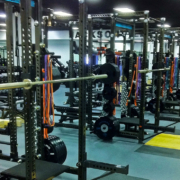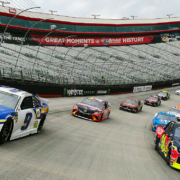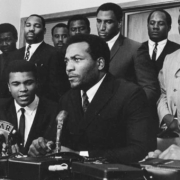Will They Play?
This week there were a lot of signs that we’ll see sports restart soon in July. Major League Baseball came to an agreement to start in a couple of weeks. The NBA says they’re going to have games and a version of the “playoffs” in a campus setting at Disney in Orlando. The NCAA has allowed some teams to begin voluntary workouts and the NFL has a plan to open training camps in late July preparing for a full, on-time season to start in September.
But it’s all experimental and speculative at this point with protocols for health and safety changing almost daily. On one hand it seems possible to play games but on the other it’s a daunting task.
“Everyone wants to make sure we get this thing right,” Jaguars Head Coach Doug Marrone has said.
But what is “right?”
Nobody knows is the honest answer.
Perhaps following what the Premier League is doing in the UK can be a guidepost. Last week they announced they had tested players and staff for the tenth week in a row, and started playing games on June 17th, joining the Bundesliga in Germany, La Liga in Spain and Serie A in Italy.
Of the 1,829 people tested this week, one was positive for Covid-19. They put together what they called a “health and safety” policy for the clubs and the players with part of it absolving the league from any legal action a player might take if they were to contract Covid-19 while playing. They can’t sue the league.
They’re playing without fans in the stadiums, making every game free on television and using a “sound carpet” on the broadcasts run by the audio technicians blended with the authentic sounds from the match. The players don’t hear the broadcast sound in the stadium.
A couple of weeks ago the PGA Tour started back up, playing tournaments with no fans. The Tour anticipates allowing 8,000 fans at The Memorial tournament in a couple of weeks. They have a very direct set of protocols to try and protect the players, yet Nick Watney tested positive a week ago Friday at the Heritage.
“Since March we have been working to develop a comprehensive health and safety plan that would be considered a best practice among professional sports leagues,” PGA Tour Commissioner Jay Monahan said on Wednesday. “While we’ve been thorough in building a plan that would mitigate as much risk as possible, we knew it would be impossible to eliminate all risk.”
They put contact tracing in effect and are testing players, caddies and officials regularly, yet several caddies tested positive causing Graham McDowell, Brooks and Chase Koepka and Webb Simpson to withdraw from this week’s event in Connecticut.
At what point do they call off the competitions to let things “cool down?”
Who knows?
Monahan didn’t give any specific scenarios where the PGA Tour would stop playing. He did admit if there were a significant number of positive tests, it would be something to consider.
Are the players going to continue to show up knowing the possibility of exposure to the virus?
“We continue to learn from an operational standpoint,” Monahan continued. “Every number hurts. We all need to remind ourselves that we’re all learning to live with this virus. It’s pretty clear that this virus isn’t going anywhere.”
Watney had an inkling he might have contracted the coronavirus when the “Whoop” strap on his wrist detected shallow breathing while he was asleep. It’s one of the signs of Covid-19. He tested positive the next day.
The Whoop strap is used by many athletes and a lot of players on the PGA Tour have been wearing one to collect physiological data throughout the day: How’s my breathing, my activity, my temperature, how am I sleeping? All of the things involved with trying to stay in peak physical condition.
Watney’s detection, even though he was asymptomatic, reportedly has pushed the Tour to purchase a thousand bands and distribute them to players, caddies and essential staff.
Those bands are also going to be made available to NBA players in what’s being called their “bubble” in Orlando. One player referred to the bands as “a tracking device.”
Testing will be almost daily at Disney but the NBA says ““a small or otherwise expected number of COVID-19 cases will not require a decision to suspend or cancel the resumption,” in their 113-page handbook for players and staff on health and safety in Orlando.
So what number constitutes “small” or “expected?”
Add to that question that a single day record of 5500 new cases were reported in Florida this week and again, nobody knows.
Baseball will rely on local governments to allow, or not allow fans into stadiums. “That’s the plan,” was Houston Astros’ owner Jim Crane’s answer when asked if he expects fans at Minute Maid Park.
“We still have to go through the player protocol,” he said. “I think the intent at some point is to get the fans in the ballpark,” alluding to the economics of the game.
Major League Baseball didn’t really address having fans at the games in their 101-page health and safety protocol, leaving the decision up to the teams and local governments.
In Texas, Governor Greg Abbott said, “For one, we hope to have the coronavirus better under control. We look forward to working with the teams to find their strategies to make sure that they’ll be able to open their stadiums safely.”
In Illinois, they’re saying, “If and when play resumes with fans, clubs must adhere to all requirements of the 2020 Best Stadium Operating Practices unless MLB specifically provides otherwise.”
So for baseball the policy remains fluid leading up to Opening Day. Last week MLB reportedly had 40 players and staff test positive.
Will that change the owner’s or the player’s minds? What number is too many?
Last week at Talladega, NASCAR experimented with have fans live at the race. In a grandstand that can hold 175,000, 5,000 fans were allowed to buy tickets to the race. They also opened forty-four RV spots. All with the restriction that you had to live within 150 miles of the track to attend. And you had to live in Alabama. No crossing state lines to see the race.
They might be able to do that at some other tracks. Bristol can hold 162,000 and Daytona 101,000 just in the main grandstand. But at both of those tracks, out of state fans are staples.
Along with basketball, operating a football team and playing that particular sport under the current conditions without acknowledging there’s a possibility of not playing or stopping because of the coronavirus seems a stretch.
“We realize we are going to have to live with COVID,” Stacey Higgins, the University of Florida’s associate athletic director for sports health said this week. “We’re going to have positive cases to deal with.”
“We’re fully prepared that we’re going to have a positive and we’re going to have to isolate that individual,” she added “If it gets to be too many, that’s where the UF Health people will help us with that process.”
Again, what’s “too many?” Nobody knows.
Florida has confirmed they have had at least 11 student-athletes from football, volleyball and soccer test positive. Their official position is that they are “well positioned to manage those cases.”
NCAA President Mark Emmert has said that without students on campus there can’t be any student-athlete activity. Add to that his comment to congressional leaders this week that all teams might not be ready to start at the same time and the uncertainty grows.
Just this week, Dr. Anthony Fauci, the Director of the National Institute of Allergy and Infectious Diseases said the NFL might have to follow the NBA’s lead and play in a “bubble” environment.
The NFL Players Association’s medical director also advised players to “stop practicing together in private workouts.” All this, after as many as ten teams in the league have reportedly had players and coaches test positive.
There are no reported cases among the Jaguars. The team started an Infectious Response Team in May to put their preventative protocols in place.
“The place feels deserted,” is how one Jaguars employee described the team’s stadium offices and training facilities downtown.
With all of the social distancing, temperature checks and constant cleaning, “It’s weird,” they added.
Don’t we all know that feeling.





